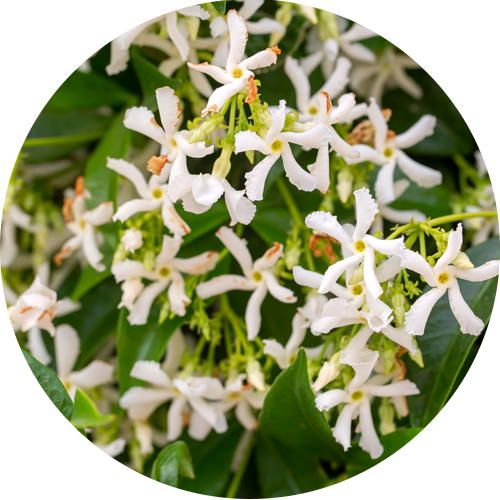The jasmine harvest season is starting, and the eyes of raw material suppliers for perfumery are turning to this delicate flower with a sweet aroma, which offers a range of facets for the perfumer and is often the heart note of a perfume. With a potent and undulating fragrance, it adds curves, roundness, or body to the perfume. It is a note that reigns alongside roses, and will continue to be an eternal source of inspiration and fundamental use for great olfactory creations.
Jasmine is a climbing plant with dark green leaves and small white or yellow flowers. It can reach heights of up to 6 meters and grows in warm and humid climates. The intensely sweet-scented jasmine flowers are used to prepare tea and pure jasmine essential oil.
The jasmine harvest takes place between June and December. The flowers are usually handpicked early in the morning, when they are most fragrant and to avoid the petals being burned by the sun. As this is a manual and precise task, where ripe flowers must be carefully separated from the leaves and stem, the harvest is slow, with each worker picking around 350 grams of flowers per hour. In one morning, a person can collect about 2 kilos of flowers, with 8,000 flowers per kilo collected.
The flowers must be processed quickly, as they are fragile and deteriorate easily. In the past, the enfleurage technique (extraction of aroma using fatty substances) was used, but nowadays volatile solvent extraction is used. This method isolates a waxy and highly fragrant material called concrete. Then, through an evaporation process, the concrete is purified to obtain the absolute, which is an essential oil. It takes 800 kilos of fresh jasmine flowers to obtain 1 kilo of concrete, which then becomes 600 grams of jasmine absolute.
There are two varieties of jasmine: grandiflorum and sambac. Depending on the soil in which they grow, they have specific characteristics in their fragrance. Egyptian jasmine is deep, sensual, sunny, and fruity; Indian jasmine sambac is fruity with notes of banana, slightly green, with honeyed and animalic notes, close to orange blossom; and jasmine grandiflorum is balanced, with green and animalic notes.
The first uses of jasmine were to scent tea and decorate floats for religious festivals. In India, the flower is woven into garlands intended for deities, but it is also used in wedding ceremonies, in the kitchen to flavor rice, works well in candles, and is even used to heal wounds or as an aphrodisiac.
In perfumery, jasmine offers a range of facets for the perfumer: it can be orchestrated differently, whether treated as a sensual, extroverted, intoxicating flower or worked as a delicate flower. We find it in large quantities in fragrances like Jardins de Bagatelle or Samsara by Guerlain. Classically, it is also often associated with roses in perfumes such as Liu by Guerlain, Chanel No. 5, Joy originel by Patou, 24 Faubourg by Hermès, Alien by Mugler, Organza by Givenchy, J’adore by Dior, and Jasmin Noir by Bulgari.
The jasmine flower is fundamental to great perfumes, and combines perfectly with other floral, citrus, and oriental notes, making each fragrance an olfactory masterpiece.
You can also find us on






